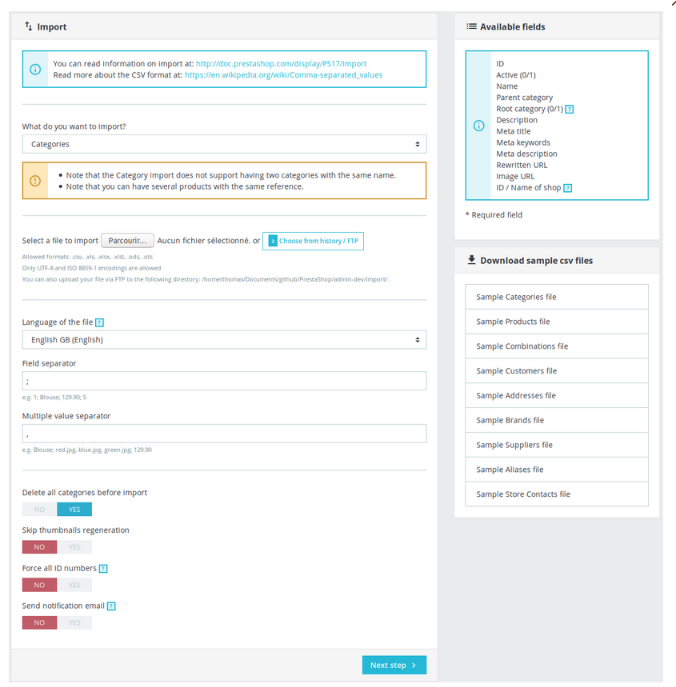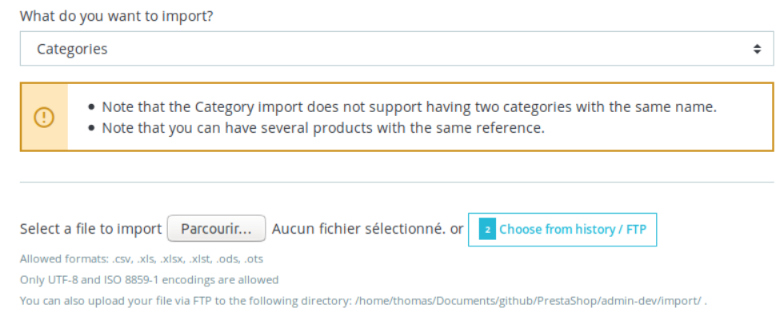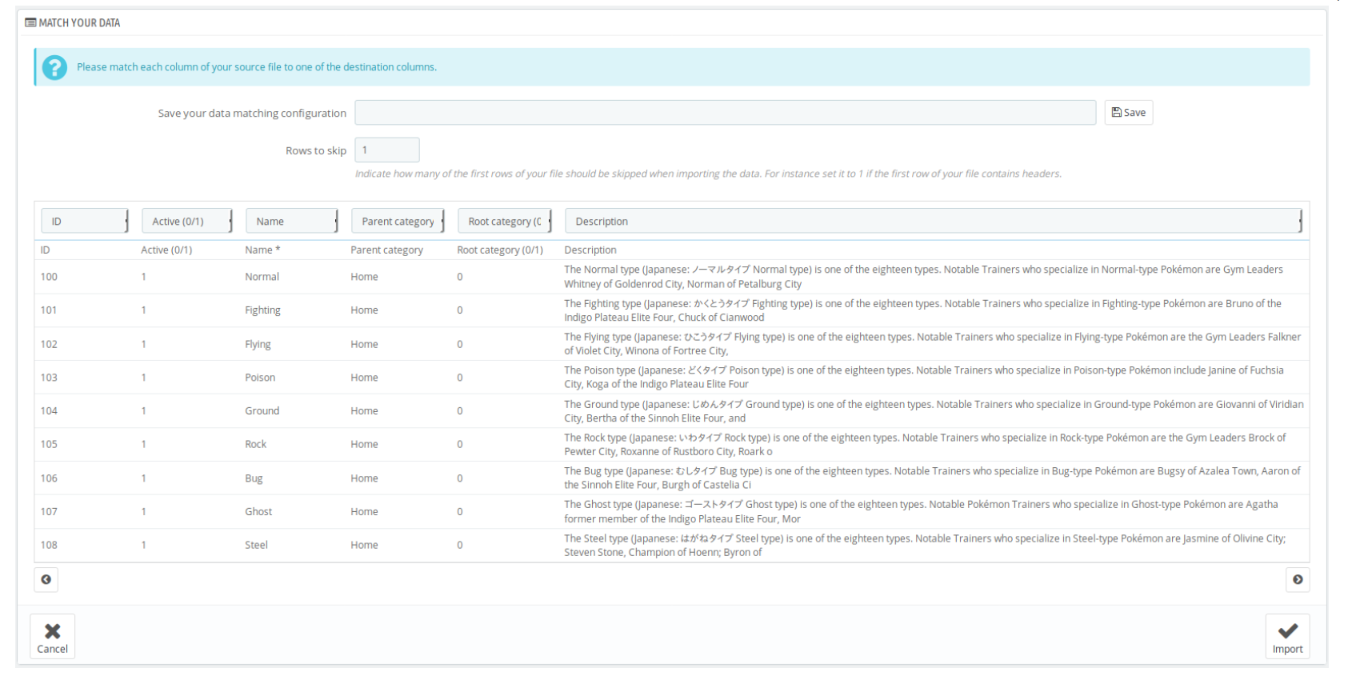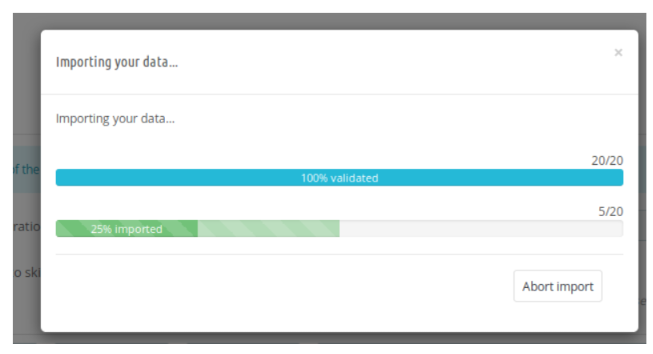How to migrate PrestaShop 1.6 to PrestaShop 1.7? Part 4
By means of the import highlight of PrestaShop
Bringing in your information should likewise be possible through the PrestaShop organization board.
That arrangement is best when your information doesn’t come from another PrestaShop, or in the event that you got your information from redid SQL demands.
It is advantageous because of its interface and its administration of unprovided sections. In contrast to imports with a MySQL customer, the PrestaShop import highlight can generally apply the default esteems for a missing data.
On the new shop, arrive at the regulator Advanced boundaries > Import.
This regulator will permit you to import the accompanying information:
- Classifications
- Items
- Mixes
- Clients
- Addresses
- Brands
- Providers
- Assumed name
- Store contacts
Whenever the situation allows, attempt to have just a single CSV record for every information classification fit to be imported. This relies upon the record size and the transfer size permitted by your worker arrangement. In the event that transferring a solitary CSV document is inconceivable, part it fifty-fifty and attempt once more.
You need to go through the setup for each import, which can be monotonous now and again. For example, if the gave sections don’t coordinate with the default construction.
Note: Like for the fare, every information class should be imported a few times if your shop is multi-language – once per language. Driving the IDs given by the CSV record will help you interface your limited information with the first one.
Import principle setup
To import information, start by transferring your CSV document. It will be done consequently when you select your document from the filesystem.
Prior to CSV determination or transfer:
A few admonitions might be shown relying upon the sort of information to import. They can give helpful exhortation about prohibited or permitted rules.
When a CSV is chosen:
Twofold check the field and various worth choices for your CSV structure. Default esteems should work in the greater part of case, yet off base qualities will make the import fizzle.
Checking the “Erase all <data> before import” (see screen capture above) alternative could be helpful to clean the exhibition content from your shop prior to bringing in your information. Be that as it may, in the event that you send out a few CSV of a similar kind of information, try to impair it prior to continuing with the second and following records.
Segment task
The subsequent advance permits you to connect the old sections with the new ones.
In the event that a section from the CSV ought not be considered, you can request PrestaShop to sidestep it by picking the main alternative from the rundown: “Overlook this segment”.
At the point when you’re prepared to continue, click on “Import”.
Import progress
From that second, you can simply trust that the cycle will finish. The time it will take relies upon the quantity of lines to import, and the picked choices.
To try not to arrive at the greatest execution season of a solicitation, the cycle will partition your information in a few pieces which will be handled in isolated HTTP demands.
The import cycle will begin by checking the time expected to handle one lump. Contingent upon the outcome, pretty much articles will be dealt with during the following HTTP demands. This gives a pleasant harmony among execution and security.
Pictures (Images)
Contingent upon how you moved your information, (i.e without the import highlight of PrestaShop), your pictures might be absent from the new shop. On the off chance that they are absent, you might need to recover them from the old.
Pictures are put away on the filesystem and their connection to an item is put away in the data set. Reestablishing them relies upon how you relocated your information:
- You kept similar IDs when you imported the items
On the off chance that the IDs are by and large something similar between the two shops, duplicating the organizer ‘/img/p’ will be sufficient to get the pictures.
Additionally, you should move the information of the tables <PREFIX>images/<PREFIX>images_lang/<PREFIX>images_shop in which the connection between your pictures and items IDs is put away.
- The item IDs have changed in information base
The pictures can be recovered also, yet this will require a few changes.
To begin with, duplicate the organizer ‘/img/p’ to get the pictures on the new shop filesystem.
At that point, you should move and adjust the information of the tables <PREFIX>images_lang/<PREFIX>images/<PREFIX>images_shop.
The tables <PREFIX>image and <PREFIX>image_shop contain a section which is a reference to item IDs. As they have changed on the new shop, you should refresh these identifiers to coordinate with the new qualities.
This work can be monotonous, that is the reason we suggest moving your information on the new shop by eliminating the current information simultaneously.
- Create thumbnails
Items pictures thumbnails should be recovered to be shown appropriately on the item page, checkout channel and so on
Go to Design > Image settings > Regenerate thumbnails to recover every one of the missing sizes.
Attachments management
Like the pictures, these organizers should be duplicated on the new worker:
- /download (Contains item connections)
- /transfer (Contains client transfers)
Like for the pictures, you should adjust some substance in your data set in the event that you were unable to keep the first item IDs.
- <PREFIX>product_attachment
- <PREFIX>customization
- <PREFIX>customization_data
Create search record
Imported items are not promptly accessible for search to your clients. You should invigorate the hunt record to make them accessible.
Go to Shop boundaries > Search > Indexing and snap on “Add missing item to the file”.
Other relocation choices for engineers
The manual interaction disclosed to fare and import information with CSV records from data set. On the off chance that you are a designer and you will construct your own instruments for movements, alternate ways exist to get the business information.
The accompanying interfaces will make your apparatuses more productive and stable than a basic CSV extraction. You can add esteems put away somewhere else than in the information base, handle your own configuration, and handle a lot more items from the source shop.
Objects Models
Item Model is an interface in the PHP codebase utilized by PrestaShop designers to demand the data set.
This can be utilized while building up a module mindful of the fare as well as import of the items from/to the information base.
For additional subtleties, see the page devoted to ObjectModels
Web administration (API)
The webservice API is another approach to recover or store information in PrestaShop.
It should be empowered from the organization board prior to being available. See the doc for additional subtleties: https://doc.prestashop.com/show/PS17/Webservice
When prepared, an API will be accessible for all the ressources empowered for your key. Essentially, the web-administration in another interface for object models, themselves interfacing the information base.
You can utilize it to recover every one of your items, classes and so forth from the principal shop, and re-embeddings them in the other shop without numerous changes.
This alternative is intriguing for individuals searching for making the cycle programmed, on the grounds that:
- the webservice has scarcely changed since PrestaShop 1.5,
- you get every one of the properties of a given item,
- in the event that a property is multi-lang, you will get the worth or a connect to another asset for each lang,
- you can get the pictures URL of an asset (i.e item), while you can’t discover straightforwardly from a data set section,
- getting an asset, or embeddings one, is finished by controlling XMLs.
Helpful connections:
- Figuring out how-to utilize the webservice API
- Getting a rundown of all accessible ressources, prepared for import/send out
Movement modules and administrations
Local area module
Albeit this arrangement isn’t made by PrestaShop, it follows the idea of fare/import introduced here and has been suggested a few time on conversation stages like the gathering.
That arrangement is a module called “MigrationPro” and is accessible on the Marketplace:
https://addons.prestashop.com/en/information movement reinforcement/8934-migrationpro-prestashop-to-prestashop-relocation tool.html
It packs two distinct modules to introduce on your old and new shop, individually dependable of the fare and import of the business information. It utilizes the article models to connect with the information base.
Backing administration
Just as for the update, you can likewise ask our help group to continue with the relocation for you.
Your information will be relocated and your viable modules will be moved. As the topic will be lost, you get rather a markdown on subjects accessible on the Marketplace. This choice is valuable for dealers who decided to utilize a current topic as opposed to building up theirs.
You can buy in for this assistance on the commercial center:
https://addons.prestashop.com/en/support/18689-overhaul pack-prestashop.html
Besides you can read other articles towards PrestaShop migration:




